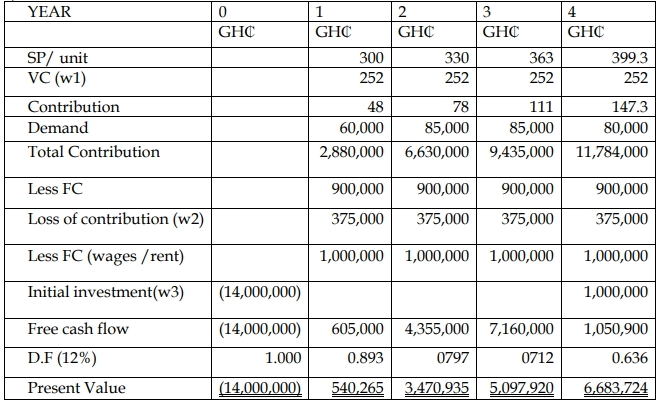- 15 Marks
Question
Kanfa Ltd received GH¢50 million as compensation from Ghana Highways Authority (GHA) when one of its properties was destroyed to pave way for the Accra–Kumasi highway construction. Management of Kanfa Ltd has decided to invest the amount received in one of three capital investment opportunities identified.
Project A:
This is a long-term project, which would run for 20 years and will require an immediate outlay of GH¢50 million and net annual cash profits as follows:
- 1st to 5th years: GH¢2 million
- 6th to 10th years: GH¢8 million
- 11th to 15th years: GH¢15 million
- 16th to 20th years: GH¢5 million
At the end of the 20th year, the project would be decommissioned at a cost of GH¢2 million.
Project B:
Kanfa Ltd is considering opening a Tourist Attraction Centre in Cape Coast, with an initial capital investment of GH¢50 million. It will operate for five years and be sold at an estimated price of GH¢5 million. The market research survey estimates the following visitor numbers and probabilities:
- 800,000 visitors (30%)
- 600,000 visitors (50%)
- 400,000 visitors (20%)
Entrance fee: GH¢40 per visitor, and each visitor is expected to spend GH¢15 on souvenirs and GH¢5 on refreshments. Variable costs per visitor: GH¢25 (including souvenirs and refreshments). Maintenance costs: GH¢2 million per annum.
Project C:
This project involves a current outlay of GH¢50 million on equipment and GH¢15 million on working capital immediately. The working capital will increase to GH¢21 million in year one. Net annual cash profits: GH¢18 million for six years. The capital equipment can be sold for GH¢5 million at the end of the project.
Other information:
- The company’s cost of capital is 12% for the three projects.
- Ignore taxation and inflation.
Required:
Calculate the Net Present Value (NPV) of each project and recommend which project the company should undertake on financial grounds.
Answer
NPV Calculation for Project A:
| Year | Net Cash Flow (GH¢000) | Discount Factor (12%) | Present Value (GH¢000) |
|---|---|---|---|
| 0 | (50,000) | 1.000 | (50,000) |
| 1-5 | 2,000 | 3.605 | 7,210 |
| 6-10 | 8,000 | 2.045 | 16,360 |
| 11-15 | 15,000 | 1.161 | 17,415 |
| 16-20 | 5,000 | 0.658 | 3,290 |
| 20 | Decommissioning cost (2,000) | 0.104 | (208) |
| NPV | (5,933) |
NPV Calculation for Project B:
- Weighted Average Visitors = (800,000 x 0.3) + (600,000 x 0.5) + (400,000 x 0.2) = 620,000 visitors
- Contribution per Visitor = Entrance fee (GH¢40) + Souvenirs (GH¢15) + Refreshments (GH¢5) – Variable cost (GH¢25) = GH¢35
| Year | Net Cash Flow (GH¢000) | Discount Factor (12%) | Present Value (GH¢000) |
|---|---|---|---|
| 0 | (50,000) | 1.000 | (50,000) |
| 1-5 | 21,700 | 3.605 | 71,018.5 |
| 5 | Sale value 5,000 | 0.567 | 2,835 |
| NPV | 23,853.5 |
NPV Calculation for Project C:
| Year | Net Cash Flow (GH¢000) | Discount Factor (12%) | Present Value (GH¢000) |
|---|---|---|---|
| 0 | (50,000) | 1.000 | (50,000) |
| 0 | Working Capital (15,000) | 1.000 | (15,000) |
| 1 | Additional Working Capital (6,000) | 0.893 | (5,358) |
| 1-6 | 18,000 | 4.111 | 73,998 |
| 6 | Release of Working Capital 21,000 | 0.507 | 10,647 |
| 7 | Sale value 5,000 | 0.452 | 2,260 |
| NPV | 16,547 |
Recommendation:
Based purely on financial grounds, Kanfa Ltd should invest in Project B since it gives the highest NPV of GH¢23,853,500.
- Tags: Capital Budgeting, Investment Appraisal, NPV, Project evaluation
- Level: Level 2
- Topic: Discounted cash flow
- Series: DEC 2023
- Uploader: Joseph








 =
=



